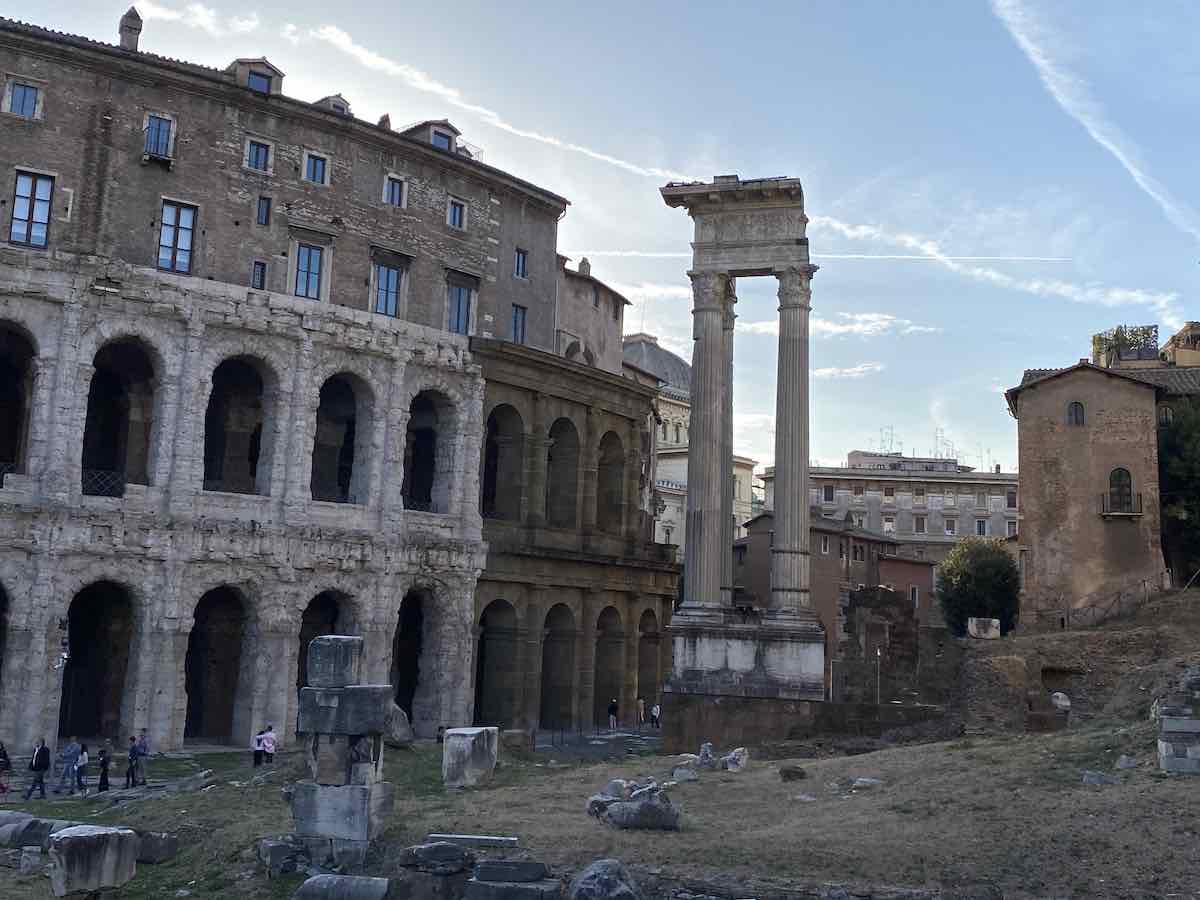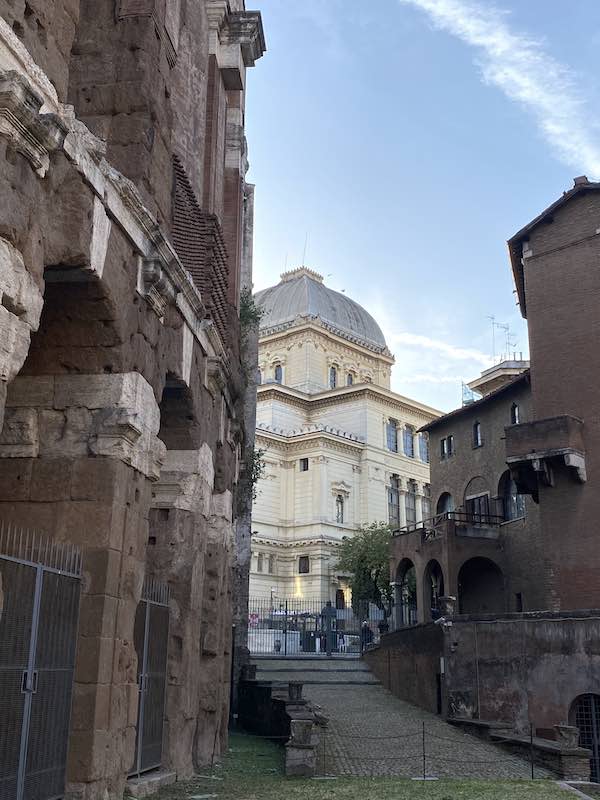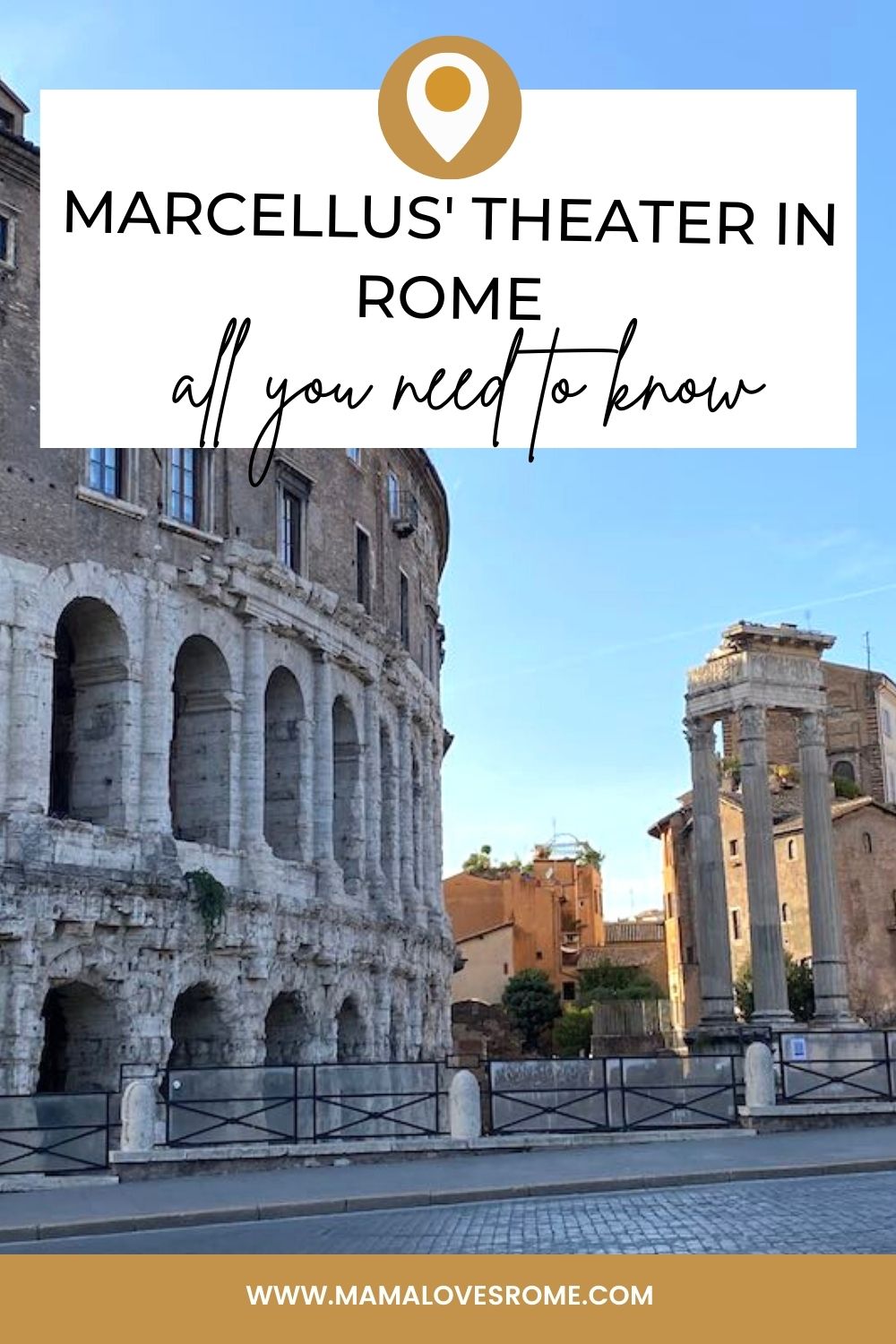Essential guide to Marcellus’ Theater, Rome’s ancient theater predating the Colosseum: location, history, tips for visiting.
The Theater of Marcellus is an ancient Roman theater in Rome’s city center.
Dating back from the I century AD, Marcellus’ theater predates the Colosseum and has a lot in common with its more famous cousin.
At first glance, first-time visitors to Rome may even mix up the two.
It is not unusual to have people getting excited pointing at the ‘Colosseum’ while passing smaller Marcellus’ Theater: if you look at photos of it, it is easy to see why!

However, the differences between the two ancient theaters of Rome are significant.
In this guide, I share essential information about Marcellus theater, how to find it and how you can weave it into your Rome itinerary.
Please note: Marcellus theater is not accessible inside. You can walk up inside its archaeological area but you can only admire it from the outside.
Please note: this post contains affiliate links. Should you make a purchase through them, we might make a small commission at no extra cost to you.
How to find Marcellus Theater: address and how to get there
Marcellus’ Theater address: Via del teatro di Marcello
Marcellus’ Thater now overlooks a busy road connecting Piazza dell’Ara Caeli (Capitoline Hill) with Piazza Santa Maria in Cosmedin and the Tiber.
You can reach it on foot from Piazza Venezia, Circus Maximus and the Jewish Ghetto.
Buses to this area are: 23, 30, 46, 63, 81, 83, 280 H. All buses serving Piazza Venezia leave you nearby.
A quick history of Marcellus’ Theater
Marcellus Theater lies in Campo Marzio, an area of Rome traditionally devoted to theatrical representations.
Ancient sources tell us that a theater already existed here in 179AD, as part of the temple of Apollo in this same location (Temple of Apollo Sosiano, some of its columns are still visible).
However, the Theater of Marcellus as we see it now dates from the I century AD.

Julius Caesar (I century BC) started the project and prepared the area, destroying pre-existing buildings when needed.
Augustus then took charge of the process: archaeologists believe the theater was completed in 17BC and was dedicated to Augustus’ nephew Marcus Claudius Marcellus, in 13 or 11 BC.
The theater stayed in use for representation until the IV century and archaeologists found proof of restoration work by Vespasian and Severus Alexander (III century), which led to believe the theater was valued and regularly attended.
During the Middle Ages, the theatre changed role and the Pierleoni and Fabi families transformed into a sort of fortress, making the most of its position, slightly elevated from the river.
In the ‘500 (XVI century) Baldassare Peruzzi built the residential portion of the complex we still see, which stayed property of the Savelli family first and the Orsini family next.
Fun fact: people still live in the apartment above Marcellus’ theater!
Around it, archaeologists and historians have reason to believe a full neighborhood developed, from medieval times onwards, with shops hosted anther the arches of the theaters and a maze of streets, piazzas and even churches.
The municipality of Rome bough the ancient, lower part of hte theater in the 1930s.
Fun and interesting facts about Marcellus’ Theater
Marcellus heater is a large ancient Roman theater, entirely free standing.
It is a self contained structure that does not use natural features such as a slope for support, in a fashion that is typical of ancient Roman theaters and sets them apart from Greek ones.
Like the Colosseum, the tare was entirely enclosed by oval walls and it had an arena (the stage), a cavea (seats for the audience) and a sceana, the stage backdrop.
The theater has a diameter of 130mt and seem to have been able to host 15.000 people, possibly up to 20.000.
To put it in context, the Colosseum, built only a century later, has a diameter of 189 mt and can host up to 50,000 spectators.
You can find more facts about the Roman Colosseum here.
The most significant elements of the theater are:
The outside
The theater facade had a curved shape. Three sets of arches and travertine columns of ionic and doric orders decorated it.
The arch keys on the lower level had large masks that would symbolize the vocation of the theater as a space for theatrical performances.
The outside of the theatre is battered by the passing of time but it is easy to appreciate and enjoy.
A gate now protects the area (open during the day, access is free) and there is a well kept, short path leading the visitor right up to the theatre.

The Cavea
The insider of Marcellus’ Thater is not accessible to the public but archaeologists gave a good description.
The cavea of the Theater of Marcellus (aka the area with the audience’s seats) had a semi-circular shape typical of Greek and Roman theaters: its walls are in tufa rock and its seats in marble.
The area below the seats was storage and archaeologists found sculptures that suggested it would have been decorated with plasterwork.
The arena and the scaena
The public would look towards the arena and the scaena, which would have been between the public and the river.
Archaeological findings suggest the scene was decorated with columns and colorful marbles and had a strong apse to protect the theater from potential river floods.
The theater would have been covered by a velario and was probably completed with 36 bronze vases to help with the acoustic.
What shows happened in Marcello’s Theater
The theatre of Marcellus used to host theatrical representations such as comedy, tragedy, and poetry shows.
These were popular pastimes in ancient Rome and would have been different form the types of shows and performances appending in Circus Maximus (chariot races mostly) and the Colosseum, which hosted also hunting games, gladiator fights and capital executions.
You can learn more about shows and games in Ancient Rome here
What to see nearby
the Theater of Marcellus is close to many interesting attractions, some in the same archaeological area as the theater, some in the immediate vicinity.
As mentioned above, the weather lies in an area with preexisting building and later ones.
In the same esplanade where we now see the theatre it is still possible to see columns belonging to the ancient temple of Apollo Sosiano and archaeologist also identifies traces of a temple to Bellona, ancient roman goddess of war. (Livy, Ab Urbe Condita, X).

The temples would have been just beside the theater, on the right is looking at it from Via del teatro di Marcello.
The columns that are still standing belong to the temple of Apollo; that of Bellona would have been just beside it.
The area would have also housed the ancient Circus Flaminius, now lost.
Beside the theater, it is now possible to admire the so called Octavia’s Portico (Portico d’Ottavia): this is a beautiful portico named after Augustus niece and is in the area f Rome called the Jewish ghetto, also very much worth a visit.
The most distinctive landmark close to the theater is Rome Synagogue, just beside it, towering above the fascinating and historically significant Jewish Ghetto of Rome.

Only a short walk from the theatre you find additional attractions:
The Capitoline Hill – one of Rome’s seven hill, then redesigned by Michelangelo
The so called Arch of Janus, one of ancient Rome’ arches
Santa Maria in Cosmedin and the Mouth of Truth
The Circus Maximus, Aventine Hill and the River Tiber are also nearby.
Where to eat near Marcellus’ Theater
Marcellus’ Theater is beside the Jewish Ghetto, one of the most famous areas of Rome for food. Giggetto Al portico d’Ottacia is one of the most traditional addressed but you can take your pick out of the many available – Jewish Roman cuisine is wonderful!
If you prefer a different type of experience, you can stretch your legs to Forno Roscioli, on the other side of the Ghetto and still very close to the theater.
For aperitivo with a view, the American Bar on top of the Otivm Hotel and elegant Circus on Via Petroselli are among my favorite rooftop terraces in Rome.
Guided tours including Marcellus’ theater
Marcellus Theater is closed to visitors and no tours of the theater as such exist.
Most tours of the Jewish Ghetto pass it however, no tour covers the theatre as such as they focus on the rich Jewish history and cuisine of the the area.
Tours of the area you may enjoy are:
Jewish Ghetto guided walking tour
Rome’s Marcellus’ Theater Guide – pin this!

